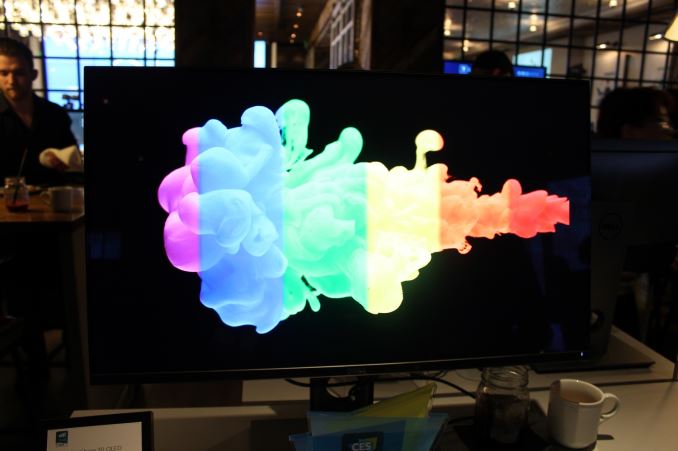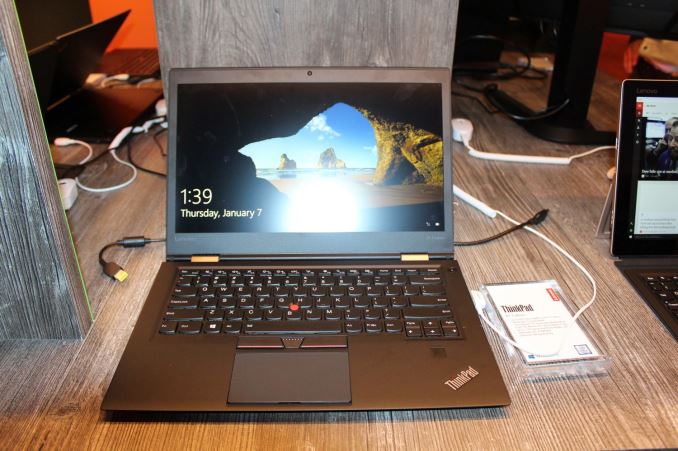CES 2016 Roundup: Total Editor Recall
by AnandTech Staff on January 26, 2016 11:00 AM EST- Posted in
- Trade Shows
- CES 2016
Senior Laptop Editor, Brett Howse
Every year we converge on Las Vegas to see all the new technology announcements from the world. The show is massive, and there is always a struggle to see as much as you can in the limited time available. This year I’ve stepped up as the senior laptop editor so there was plenty for me to cover in the couple of days I had boots on the ground, so to speak.
I think for me the most amazing announcement was the incredible number of devices that were available with OLED displays. I’ve long been a fan of the deep black levels OLED can produce and I’ve been wanting to see some on notebooks. We got that and more. There were several notebooks announced with OLED including the Lenovo ThinkPad X1 Yoga, the HP x360, and the Alienware 13, but I think the most impressive was the 30-inch Dell UltraSharp display. The price is very high but new uses of technology always start that way.
OLED is not the holy grail either. It has power draw issues on high APL workflows which is kind of the standard in the PC space. But as a first step into the PC sector, I was very impressed with the displays on all of the devices. It doesn’t even appear that the price premium is going to be that bad on the notebooks so hopefully we will see more innovation with these displays.
Another trend I’ve noticed, and this didn’t start at CES, is just how thin and light powerful notebooks have become. Everyone was keen to show off their latest notebooks based on Skylake, and it’s fairly stunning how much computer you can pack into such a small body. The LG gram is a great example of this. LG decided to use traditional Ultrabook parts in a 15-inch chassis, and when you see a 15-inch notebook under three pounds, it’s almost like it's not there. Very impressive.
Often the trade off of this is battery life though, and with the rare exception many companies have been going the smartphone route where thin and light trumps extra battery life. But even with that said, notebooks like the ThinkPad X1 Carbon got thinner and lighter this year but also increased battery capacity. High density batteries come into play here. I think it’s going to be a trend we continue to see but hopefully device efficiency makes up the difference. Everyone has different needs as far as battery life, and even the worst performers in 2016 last far longer than notebooks only a couple of years old.
The final thing I want to bring up is the decline in the PC market. Depending on what numbers you look at, the PC market dropped 6-10% in 2015 when looking at unit sales. I suppose that’s not a huge surprise considering how we interact with different devices now, and we have not seen an increase in system requirements for Windows since Vista in 2007, so old computers are still getting by. I’m as guilty of this as anyone, since I just upgraded to an i7-6700K system from an i7-860 system I believe I built in 2009. My old system was still good and rarely did I wish for more performance. Tablets have also taken some of our usage share, and with their light weight operating systems people are already finding they have a long lifespan. But despite the bad news about PC sales, it actually has been very good for consumers.
The quality of laptops released at CES were clearly a step ahead of what they have been in the past. In the past quality was secondary to quantity, but with the drop in volume, everyone has had to step up their game. Build quality, display quality, and performance have all taken a big step forward, especially for companies competing in the premium space. Users also want a nice looking laptop, and we saw the Dell XPS 13 come along last year and set the bar pretty high. Dell then took the styling and applied it to the XPS 15 to great effect, as well as their new Latitude 13. No one else is standing idle though, and there have been some excellent designs by other companies as well like the HP x360 and Lenovo 900.
So although the numbers suggest an industry in decline, I saw plenty at CES to make me hopeful for the future that at least the devices are improving for those that want them.













44 Comments
View All Comments
JonnyDough - Wednesday, January 27, 2016 - link
"With these things in mind, it does make sense that Samsung is pushing in a different direction. When looking at the TV market, I don’t see OLED as becoming a complete successor to LCD, while I do expect it to do so in the mobile space. TVs often have static parts of the interface, and issues like burn in and emitter aging will be difficult to control."Wouldn't that be opposite? Phones and tablets are often used in uncontrolled environments, and have lock screens and apps that create static impressions on a display as much as any tv in my opinion. I think OLEDs could definitely penetrate the television market, and I think as a result of either they will trickle over into other markets due to cost. Unless a truly viable alternative to OLEDs can overtake these spaces, I think that continual refinements in OLED help it prove to be a constantly used and somewhat static technology. Robots are moving more and more towards organics as well - so it would make sense that in the future we borrow more and more from nature as we come to understand it.
Brandon Chester - Wednesday, January 27, 2016 - link
Relative to TVs you keep your phone screen on for a comparatively short period of time. Aging is actually less of an issue in the mobile market. Aging is the bigger issue with TV adoption, with burn in being a secondary thing which could become a larger problem with the adoption of TV boxes that get left on with a very static UI.JonnyDough - Thursday, January 28, 2016 - link
You brought up some good points. I wonder though how many people have a phablet and watch Netflix or HBO now when on the road in a hotel bed.Kristian Vättö - Thursday, January 28, 2016 - link
I would say the even bigger factor is the fact that TV upgrade cycles are much longer than smartphones. While the average smartphone upgrade cycle is now 2-2.5 years, most people keep their TVs for much longer than that, and expect them to function properly.Mangemongen - Tuesday, February 2, 2016 - link
I'm writing this on my 2008, possibly 2010 Panasonic plasma TV which shows static images for hours every day, and I have seen no permanent burn in. There is merely some slight temporary burn in. Is OLED worse than modern plasmas?JonnyDough - Wednesday, January 27, 2016 - link
What we need are monitors that have a built in GPU slot, since AMD is already helping them to enable other technologies, why not that? Swappable GPUs on a monitor, the monitors already have a PSU built in so why not? Put a more powerful swappable PSU with the monitor, a mobile like GPU, and voila. External plug and play graphics.Klug4Pres - Wednesday, January 27, 2016 - link
"The quality of laptops released at CES were clearly a step ahead of what they have been in the past. In the past quality was secondary to quantity, but with the drop in volume, everyone has had to step up their game."I don't really agree with this. Yes, we have seen some better screens at the premium end, but still in the sub-optimal 16:9 aspect ratio, a format that arrived in laptops mainly just to shave a few bucks off cost.
Everywhere we are seeing quality control issues, poor driver quality, woeful thermal dissipation, a pointless pusuit of ever thinner designs at the expense of keyboard quality, battery life, speaker volume etc., a move to unmaintanable soldered CPUs and RAM.
Prices are low, quality is low, volumes are getting lower. Of course, technology advances in some areas have led to improvements, e.g. Intel's focus on idle power consumption that culminated in Haswell battery-life gains.
rabidpeach - Wednesday, January 27, 2016 - link
yea? 16k per eye? is that real, or him make up numbers to make radeon have something to shoot for in future?boeush - Wednesday, January 27, 2016 - link
There are ~6 million cones (color photoreceptors) per human eye. Each cone perceives only the R, G, or B portion (roughly speaking), making for roughly 2 megapixels per eye. Well, there's much lower resolution in R, so let's say 4 megapixels to be generous.That means 4k, spanning the visual field, already exceeds human specs by a factor of 2, at first blush. Going from 4k to 16k boosts pixel count by a factor of 16, we end up exceeding human photoreceptor count by a factor of 32!
But there's a catch. First, human acuity exceeds the limit of color vision, because we have 20x more rods (monochromatic receptors) than cones, which provide very fine edge and texture information over which the color data from the cones is kind of smeared or interpolated by the brain. Secondly, most photoreceptors are clustered around the fovea, giving very high angular resolution over a small portion of the visual field - but we are able to rapidly move our eyeballs around (saccades), integrating and interpolating the data to stitch and synthesuze together a more detailed view than would be expected from a static analysis of the optics.
In light of all of which, perhaps 16k uniformly covering the entire visual field isn't such overkill after all if the goal is the absolute maximum possible visual fidelity.
Of course, running 16k for each eye at 90+ Hz (never even mind higher framerates) would take a hell of a lot of hardware and power, even by 2020 standards. Not to mention, absolute best visual fidelity would require more detailed geometry, and more accurate physics of light, up to full-blown real-time ray-tracing with detailed materials, caustics, global illumination, and many bounces per ray - something that would require a genuine supercomputer to pull off at the necessary framerates, even given today's state of the art.
So ultimately, its all about diminishing returns, low-hanging fruit, good-enough designs, and balancing costs against benefits. In light of which, probably 16k VR is impractical for the foreseeable future (meaning, the next couple of decades)... Personally, I'd just be happy with a 4k virtual screen, spanning let's say 80% of my visual field, and kept static in real space via accelerometer-based head-tracking (to address motion sickness) with an option to intentionally reposition it when desired - then I wouldn't need any monitors any longer, and would be able to carry my high-res screen with/on me everywhere I go...
BMNify - Wednesday, January 27, 2016 - link
"AMD's Raja Koduri stating that true VR requires 16K per eye at 240 Hz."well according to the bbc r&d scientific investigations found the optimal being close to the 300 fps we were recommending back in 2008 and prove higher frame rates dramatically reduce motion blur which can be particularly disturbing on large modern displays.
it seems optimal to just use the official UHD2 (8k) spec with multi surround sound and the higher real frame rates of 100/150/200/250 fps for high action content as per the existing bbc/nhk papers... no real need to define UHD3 (16k) for near eye/direct retina display